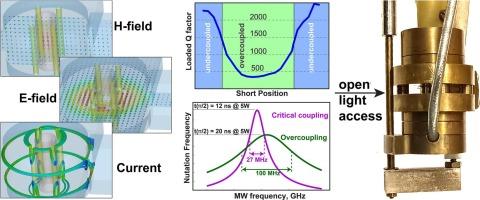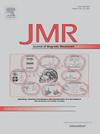用于q波段脉冲EPR实验的可调谐开放式TE011谐振腔的设计与表征
IF 1.9
3区 化学
Q3 BIOCHEMICAL RESEARCH METHODS
引用次数: 0
摘要
电子顺磁共振(EPR)是研究金属蛋白和酶的结构和功能的重要技术。这条研究路线中各种各样的问题需要多种多样的仪器。在这项工作中,我们探索了开放谐振器概念在q波段(≈34 GHz)通用高可调谐TE011谐振器设计中的实用性。使用概念验证计算,我们建立了与所需仪器规格兼容的可行关键参数范围。然后,我们提出了谐振器的设计,目标是易于执行和处理。实验结果表明,该谐振器具有较高的可调性。具体地说,我们证明了谐振器可以在使用匹配短路的带宽变化三倍的情况下进行临界耦合和过耦合。我们还表明,谐振器可以通过可移动的轴向柱塞与频率调谐相结合,使其能够使用相对窄带宽的微波仪器处理大范围的样品。此外,由于其高可调性,谐振器对制造缺陷的容忍度非常高,这使得它价格合理,并且易于使用最少的工具执行。我们还在研究中讨论了谐振器的长期使用,突出了它的多功能性。本文章由计算机程序翻译,如有差异,请以英文原文为准。

Design and characterization of a tunable open TE011 resonator for Q-band pulse EPR experiments
Electron Paramagnetic Resonance (EPR) is an important technique for the investigation of the structure and function of metalloproteins and enzymes. The variety of questions in this line of research requires versatile instrumentation. In this work, we explored the utility of the open resonator concept for a general-use highly tunable TE011 resonator design at Q-band frequencies (≈ 34 GHz). Using proof-of-concept calculations, we establish a viable range of critical parameters compatible with the desired instrument specifications. We then present the resonator design, targeting ease of execution and handling. Experimental characterization of the built resonator shows high tunability. Specifically, we show that the resonator can be critically coupled and overcoupled with a three-fold change in the bandwidth using a matching short. We also show that the resonator can be incorporated with frequency tuning by means of movable axial plungers, allowing it to work with a wide range of samples using relatively narrow-bandwidth microwave instrumentation. Furthermore, because of its high tunability, the resonator is very tolerant of manufacturing imperfections, which makes it affordable and easy to execute with minimal tooling. We also discuss the long-term use of the resonator in our research, highlighting its versatility.
求助全文
通过发布文献求助,成功后即可免费获取论文全文。
去求助
来源期刊
CiteScore
3.80
自引率
13.60%
发文量
150
审稿时长
69 days
期刊介绍:
The Journal of Magnetic Resonance presents original technical and scientific papers in all aspects of magnetic resonance, including nuclear magnetic resonance spectroscopy (NMR) of solids and liquids, electron spin/paramagnetic resonance (EPR), in vivo magnetic resonance imaging (MRI) and spectroscopy (MRS), nuclear quadrupole resonance (NQR) and magnetic resonance phenomena at nearly zero fields or in combination with optics. The Journal''s main aims include deepening the physical principles underlying all these spectroscopies, publishing significant theoretical and experimental results leading to spectral and spatial progress in these areas, and opening new MR-based applications in chemistry, biology and medicine. The Journal also seeks descriptions of novel apparatuses, new experimental protocols, and new procedures of data analysis and interpretation - including computational and quantum-mechanical methods - capable of advancing MR spectroscopy and imaging.

 求助内容:
求助内容: 应助结果提醒方式:
应助结果提醒方式:


